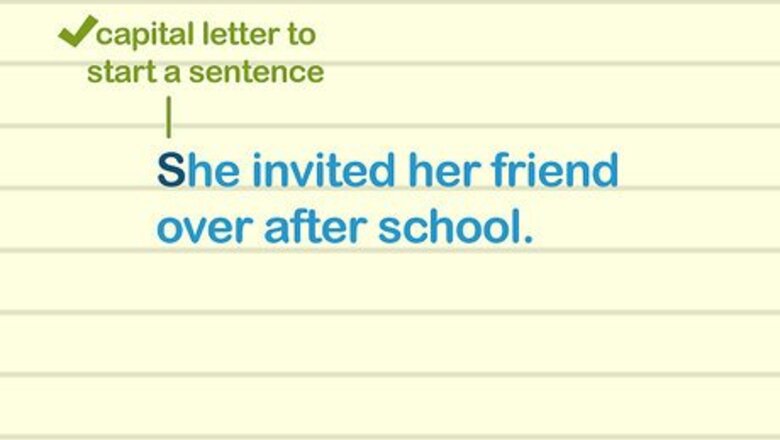
views
Using Proper Capitalization
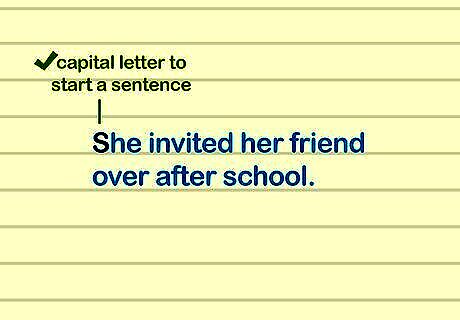
Always start a sentence with a capital letter. Unless you're an avant-garde poet or you're starting a sentence with a brand name like "wikiHow" or "iPod," you will need to capitalize the first letter of every sentence. Here is an example of proper capitalization at the beginning of a sentence: She invited her friend over after school.
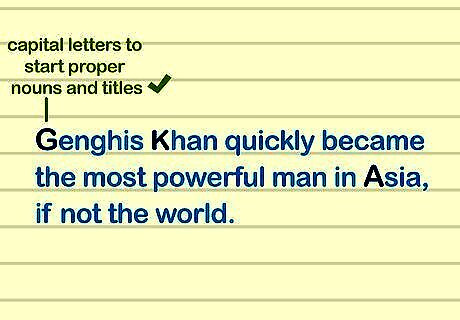
Use capital letters to start proper nouns and titles. In addition to starting sentences, capital letters should also occur at the start of proper nouns and titles. Proper nouns are the names of specific people, places, and things. Titles, which are a type of proper noun, are the names of works of art (books, movies, plays, etc.), institutions, geographical areas, and much more. Titles can also be honorifics (Her Majesty, Mr. President, etc.). Titles and proper nouns consisting of more than one word should have every word capitalized, except for small words and articles like "the," "an," "and," etc. The first word of a title should always be capitalized (with the above "brand name" exception). Here are a few examples of capital letters being used for proper nouns and titles: Genghis Khan quickly became the most powerful man in Asia, if not the world. In her opinion, Queen Roberta's favorite museum in the world is the Smithsonian, which she visited during her trip to Washington, D.C., last year.
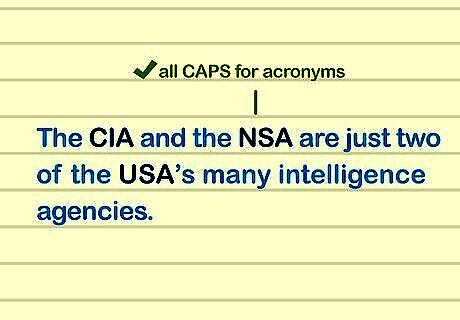
Use capital letters for acronyms. An acronym is a word (or a "coined" word) formed from the first letter of every word in a long proper noun or title. Acronyms are frequently used to shorten long proper nouns that would be awkward to reprint in their entirety every time they are mentioned. Sometimes the letters of an acronym are separated by periods. Here is an example of acronyms made from capital letters: The CIA and the NSA are just two of the USA's many intelligence agencies.
Using End-of-Sentence Punctuation Marks
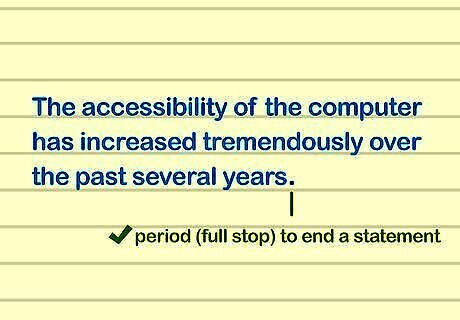
Use a period (full stop) to end declarative sentences and statements. Also after initials, as in Alfred D. Smith. Every sentence contains at least one punctuation mark -- the one at its end. The most common of these sentence-ending punctuation marks is the period (".", also called a "full stop"). This simple dot is used to mark the end of a sentence that is declarative. Most sentences are declarative. Any sentence that states a fact or describes or explains an idea is declarative. Here is an example of a period (full stop) being used correctly at the end of a sentence:The accessibility of the computer has increased tremendously over the past several years.
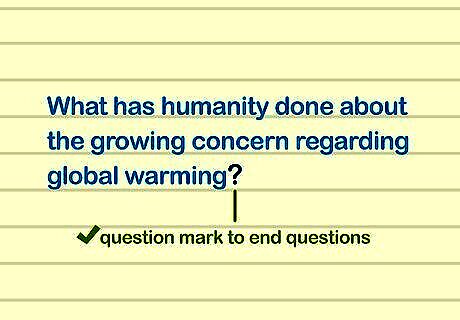
Use a question mark to end questions. The question mark ( "?" ) used at the end of a sentence denotes an interrogative sentence -- basically, a question. Use this punctuation mark at the end of any question, query, or inquiry. Here is an example of a question mark being used correctly at the end of a sentence:What has humanity done about the growing concern regarding global warming?
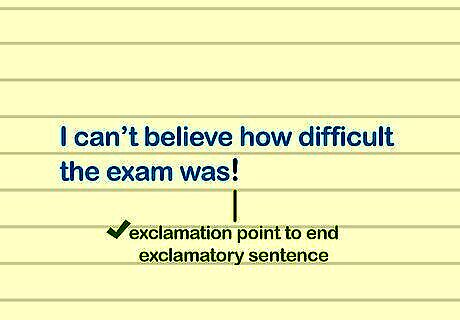
Use an exclamation point to end exclamatory sentences. The exclamation point ("!", also called an "exclamation mark" or "shout mark") suggests excitement or strong emphasis. The exclamation point is used to end exclamations -- short expressions of intense emotion that are often only one word long. Here are two examples of an exclamation point being used correctly at the end of a sentence:I can't believe how difficult the exam was! Eek! You scared me!
Using Commas
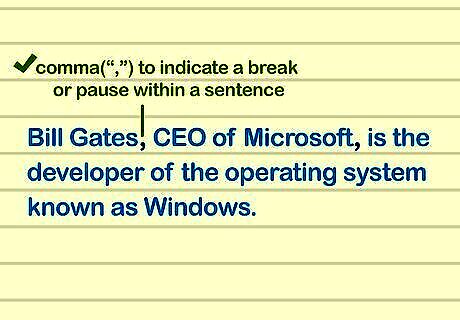
Use a comma to indicate a break or pause within a sentence. The comma (",") is a very versatile punctuation mark. There are dozens of situations that might require the use of a comma. One frequent case is the appositive -- a break within a sentence that supplements and adds information to the subject. Here is an example of commas being used to create a break in a sentence:Bill Gates, CEO of Microsoft, is the developer of the operating system known as Windows.
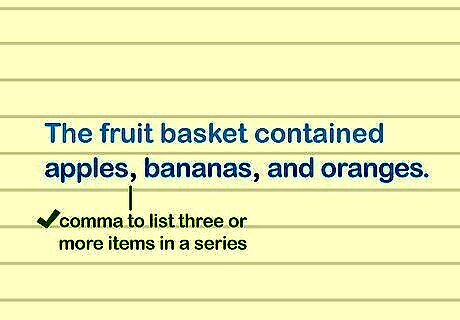
Use a comma when listing three or more items in a series. A common use of commas is to separate items that are being listed in a sequence. Usually commas are written between each of the items and between the second-to-last item and a subsequent conjunction. However, many writers omit the comma before the conjunction (called a serial comma or "Oxford comma"), as conjunctions like "and" will signal the end of the list even without the final comma. Here are two examples of commas used in listed series -- one with an Oxford Comma and one without.The fruit basket contained apples, bananas, and oranges. The computer store was filled with video games, computer hardware and other electronic paraphernalia.
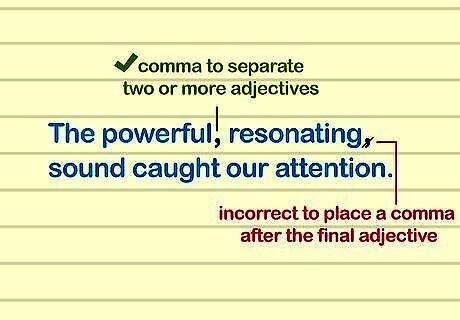
Use a comma to separate two or more adjectives describing a noun. Sometimes consecutive adjectives are used to describe a single subject with multiple qualities. This use of commas is similar to using them to separate items in a series, with one exception: it is incorrect to place a comma after the final adjective. Here are examples of correct and incorrect comma usage when it comes to separating adjectives: CORRECT: The powerful, resonating sound caught our attention. INCORRECT: The powerful, resonating, sound caught our attention.
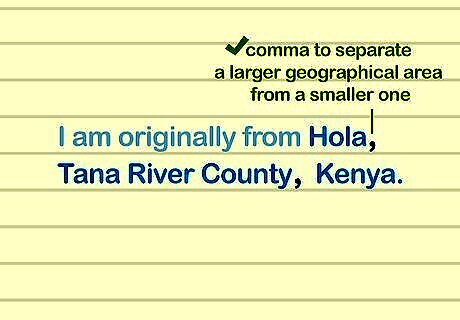
Use a comma to separate a larger geographical area from a smaller one located within it. Specific geographical places or areas are usually named by starting with the smallest location's name and then proceeding to the larger area. For instance, you might refer to a specific city by naming the city itself, followed by the state or province it is in, followed by the surrounding country. Each geographic name (except the last) is followed by a comma. Note that a comma is used after the last (largest) geographical area if the sentence continues. Here are two examples of correct comma usage when it comes to naming geographical areas:I am originally from Hola, Tana River County, Kenya. Los Angeles, California, is one of the largest cities in the United States.
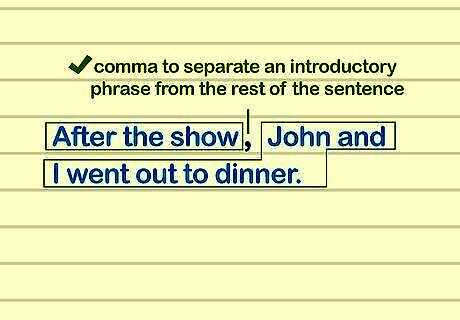
Use a comma to separate an introductory phrase from the rest of the sentence. An introductory phrase (which is usually one or more prepositional phrases) briefly introduces the sentence and provides context but is not part of the sentence's subject or predicate. Therefore, it should be separated from the main clause by a comma. Here are two examples of sentences with introductory phrases separated from the rest of the sentence by commas:After the show, John and I went out to dinner. On the back of my couch, my cat's claws have slowly been carving a large hole.
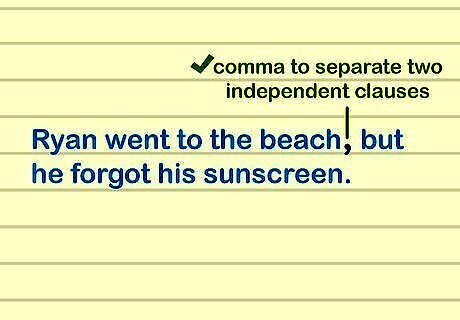
Use a comma to separate two independent clauses. Having two independent clauses in a sentence simply means that you could split the sentence into two shorter sentences while preserving the original meaning. If your sentence contains two independent clauses that are separated by a conjunction (such as and, as, but, for, nor, so, or yet), place a comma before the conjunction. Here are two examples of sentences containing independent clauses:Ryan went to the beach yesterday, but he forgot his sunscreen. Water bills usually rise during the summer, as people are thirstier during hot and humid days.
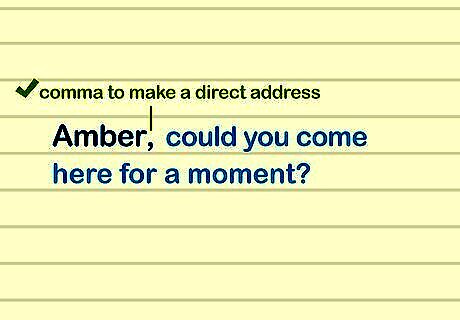
Use a comma when making a direct address. When calling one's attention by saying his/her name at the start of a sentence, separate the person's name from the rest of the sentence with a comma. Note that this comma is somewhat rare in writing, because this is something normally done while speaking. It's more common for a writer to employ other methods to indicate who is speaking to whom. Here is an example of a direct address:Amber, could you come here for a moment?
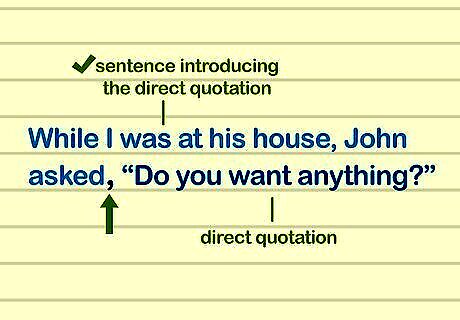
Use a comma to separate a direct quotation from the sentence introducing it. A comma should occur after the word immediately preceding a quotation that is being introduced with context or a description. On the other hand, it is not necessary to use a comma before an indirect quote (where you are paraphrasing someone's words without quoting them exactly). Additionally, a comma is usually not necessary if you are not quoting an entire statement, but only a few words from it. Here is an example of a direct quotation that requires a comma:While I was at his house, John asked, "Do you want anything to eat?" Here is an example of an indirect quotation that does not require a comma:While I was at his house, John asked me if I wanted anything to eat. Here is an example of a partial direct quotation, which, due to its brevity and its use within the sentence, does not require a comma: According to the client, the lawyer was "lazy and incompetent."
Using Colons and Semicolons

Use a semicolon to separate two related but independent clauses. The proper use of a semicolon is similar, but not identical, to that of a comma. The semicolon marks the end of one independent clause and the start of another within a single sentence. Note that, if the two clauses are very wordy or complex, it is better to use a period (full stop) and form two sentences instead. Here's an example of a semicolon being used correctly:People continue to worry about the future; our failure to conserve resources has put the world at risk. A semicolon takes the place of a period, and it is used in parallel construction. For instance, if you write I love bananas, and I love apples, instead of having an and, you can write I love bananas; I love apples. Parallel construction means you have the same thing on both sides of that semicolon, subject, verb, subject, verb.
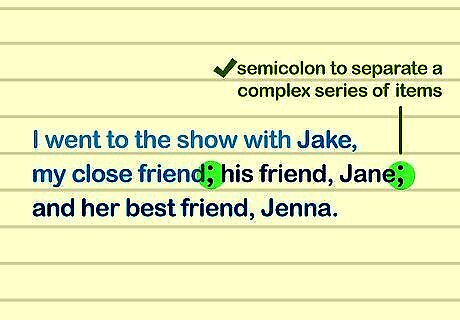
Use a semicolon to separate a complex series of items. Usually, the items in a series are separated by commas, but for cases in which one or more items require comment or explanation, semicolons can be used in conjunction with commas to keep the reader from becoming confused. Use semicolons to separate items and their explanations from one another. To separate an item from its own explanation, use a comma. Here's an example of semicolons being used correctly in a list whose meaning might otherwise be ambiguous:I went to the show with Jake, my close friend; his friend, Jane; and her best friend, Jenna.
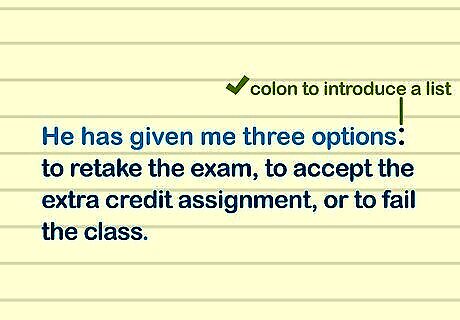
Use a colon to introduce a list. Be careful, however, not to use a colon when stating an idea that requires naming a series of items. The two are similar, but distinct. Often the sentence-ending words "the following" or "as follows" will call for the use of a colon when they are followed by new, explanatory information. Here's an example of a colon being used correctly in this fashion: The professor has given me three options: to retake the exam, to accept the extra credit assignment, or to fail the class. Here, on the other hand, is an incorrect example: The Easter basket contained: Easter eggs, chocolate rabbits, and other candy. In this case you would simply omit the colon.
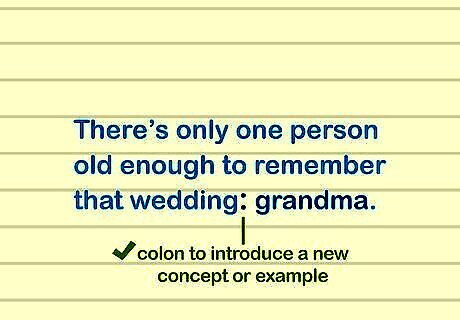
Use a colon to introduce a new concept or example. Colons can also be used after a descriptive phrase or explanation to imply that the next piece of information will be the thing being described or explained. It can help to think of this as introducing a list containing only one item. Here's an example of a colon being used properly in this way:There's only one person old enough to remember that wedding: grandma.
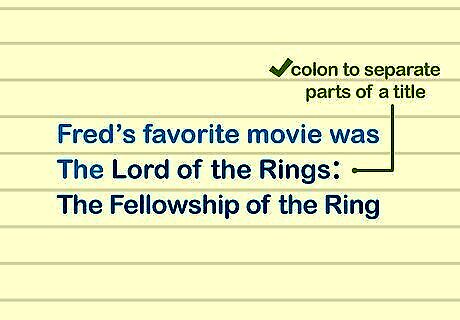
Use a colon to separate parts of a title. Some works of art, particularly books and movies, can have long, subdivided titles. In these cases, what follows the main title is called a subtitle. Use colons to separate them. Here's an example of colons being used in this way to subdivide lengthy titles: Fred's favorite movie was The Lord of the Rings: The Fellowship of the Ring, though Stacy preferred its sequel, The Lord of the Rings: The Two Towers.
Using Hyphens and Dashes
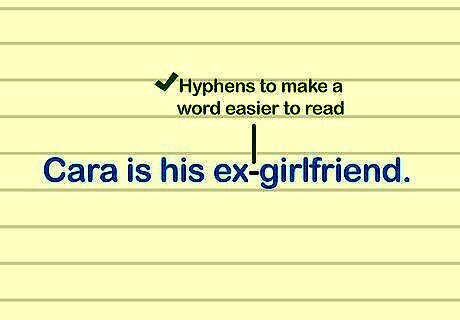
Use a . The purpose of this hyphen is to make the word easier to read. For instance, if you were to leave the hyphen out of the word re-examine, it would be reexamine, where the double "e" could be confusing. Many words do not require a hyphen to separate the prefix from the word, such as restate, pretest, and undo. Let a dictionary be your guide for when to use the hyphen after a prefix. Here's an example of good hyphen usage:Cara is his ex-girlfriend.

Use hyphens when creating compound words from several smaller words. If you've ever written about anything that's gold-plated, radar-equipped, or one-size-fits-all, you've used a hyphen in this way. To build a long, descriptive word out of two or more component words, use hyphens to separate the "pieces" from each other. Here's an example of a hyphen used to build a compound word:The up-to-date newspaper reporters were quick to jump on the latest scandal.
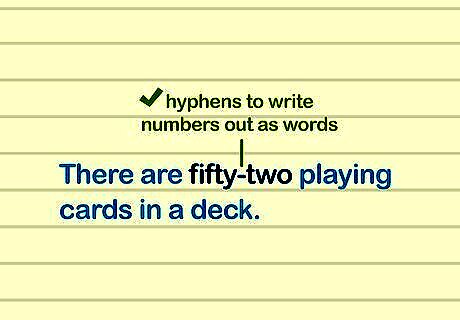
Use a hyphen when writing numbers out as words. Separate the two words of any number under one hundred with a hyphen. Be careful with spelling out numbers above one hundred — if the number is used as an adjective, it is completely hyphenated, since all compound adjectives are hyphenated. (This is the one-hundredth episode). Otherwise, a hyphen should occur only if a number lower than 100 is embedded within a larger number, e.g., He lived to be one hundred twenty-one. Don't use "and" when writing numbers, as in "The amount is one hundred and eighty." This is a common error in the US and Canada, where the "and" is usually omitted. Elsewhere in the English-speaking world, however, the "and" can be included. Here are two examples of hyphens being used in numbers below and above one hundred, respectively:There are fifty-two playing cards in a deck. The packaging advertised one thousand two hundred twenty-four firecrackers, but it contained only one thousand.
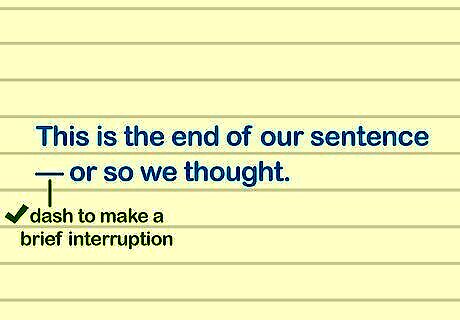
Use a dash when making a brief interruption within a statement. The dash ("--" or "—") is slightly longer than the hyphen and is used to convey a sudden change of thought, an additional comment, or a dramatic qualification within a sentence. It can also be used to add a parenthetical statement for further clarification, but this should still be relevant to the sentence. Otherwise, use parentheses. Keep in mind that the rest of the sentence should still flow naturally as if the dashed material were not there. To judge whether a dash is appropriate, try to remove the words between the dashes. If the sentence appears disjointed or does not make sense, you may need to revise it instead of using the dashes. There should be spaces before and after a dash in British English. Here are two examples of proper dash usage: An introductory clause is a brief phrase that comes — yes, you guessed it — at the beginning of a sentence. This is the end of our sentence — or so we thought.

Use a hyphen to split a word between two lines. Though this use is not as common today, the hyphen ("-") was once a common punctuation mark on typewriters, used when a long word had to be split between two lines. This system is still seen in some books, but the justification capacity of computer word processing programs has made this rarer. Here's an example of a hyphen being used to split a word that's cut into two pieces by a line break: No matter what he tried, he just couldn't get the novel's elec-trifying surprise ending out of his head.
Using Apostrophes
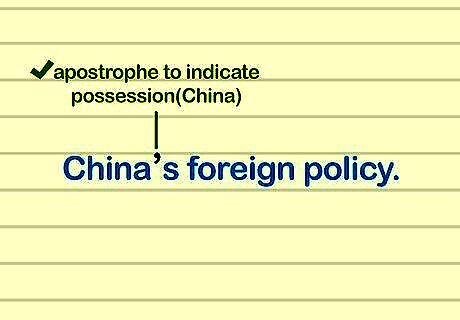
Use the apostrophe together with the letter s to indicate possession. The apostrophe (" ' ") has a variety of uses for conveying the concept of possession. Be aware of the difference in using an apostrophe with singular or plural nouns. A singular noun will use the apostrophe before the "s" ('s), whereas the plural version of that noun will use the apostrophe after the "s" (s'). This use comes with several stipulations discussed below. Be mindful of nouns that are always considered to be plural, such as children and people. Here you should use 's even though the nouns are plural. Also be aware of pronouns that are already possessive and do not require apostrophes, such as hers and its. (It's means it is or it has). Their is possessive without apostrophe or s, except as a predicate adjective, where it becomes theirs. Here is an example of an apostrophe used to show possession with a singular noun:The hamster's water tube needs to be refilled. Here is an example of an apostrophe used for showing possession with a plural noun:In the pet store, the hamsters' bedding needed to be changed. Here is an example of an apostrophe used for showing possession with a plural noun that doesn't end with "s":These children's test scores are the highest in the nation.
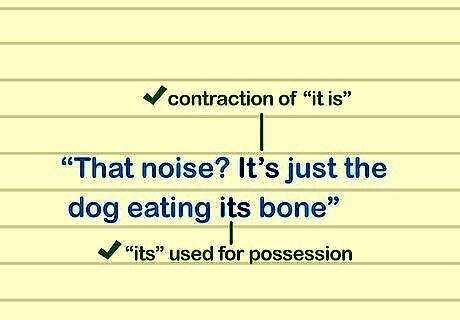
Use the apostrophe to combine two words to make a contraction. Contractions are shortened combinations of two words. For example, cannot becomes can't, "it is" becomes "it's", you are becomes you're, and "they have" becomes they've. In every contraction, the apostrophe replaces the letters that are omitted from one or both words. Be sure to use the possessive pronoun your and the contraction you're appropriately. It is a common mistake to interchange them. Here is an example of apostrophes used for a contraction of it is and a singular noun with possession, while correctly being omitted for possessive pronouns (hers, theirs, its):Friends of hers explained that it's her idea, not theirs, to refill the hamster's water tube and change its bedding.
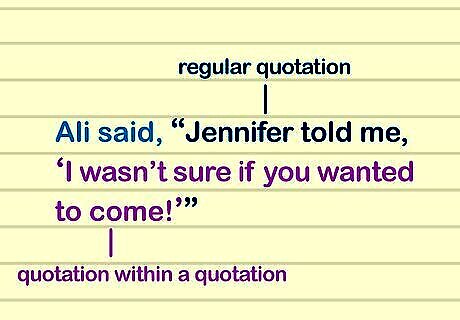
Use a single quotation mark within a regular quotation to indicate a quotation within a quotation. Single quotation marks, which look almost identical to apostrophes, are used to separate quotations from other quotations which surround them. Use these carefully: always make sure every quotation mark used to start a quote is paired with a corresponding one at the end of the quote. Here is an example of a quote-within-a-quote:Ali said, "Anna told me, 'I wasn't sure if you wanted to come!'"
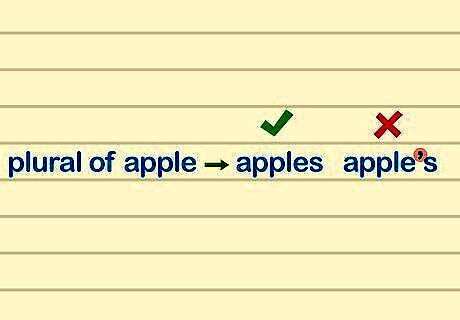
Don't use an apostrophe with an s to make a singular noun into a plural noun. This is a very common mistake. Remember that apostrophes are not used to show the simple pluralization of a noun. Here are examples of correct and incorrect apostrophe usage:CORRECT - apple → apples INCORRECT - apple → apple's
Using Slashes
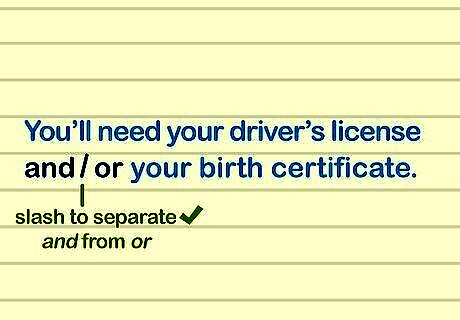
Use the slash to separate and from or, when appropriate. Slashes ( " / " ) in phrases like and/or suggest that the options described are not mutually exclusive. Here is an example of good "and/or" usage:To register, you will need your driver's license and/or your birth certificate.
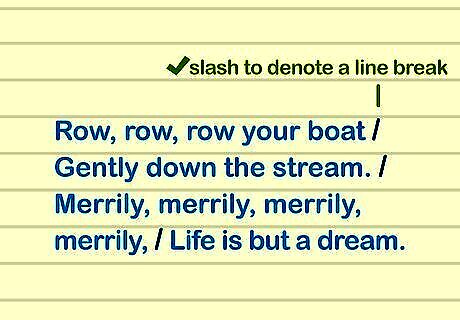
Use the slash when quoting lyrics and poetry to denote a line break. Slashes are especially useful when it is impractical to recreate the original formatting of a poem or song. When using slashes in this way, be sure to include spaces before and after the slashes. Here is an example of slashes used to mark line breaks in a song:Row, row, row your boat / Gently down the stream. / Merrily, merrily, merrily, merrily, / Life is but a dream.
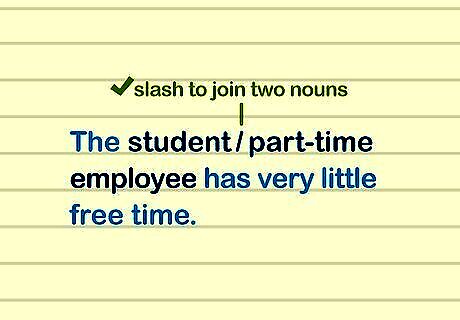
Also use the slash to replace the word and when joining two nouns. By replacing and with a slash, you suggest that there is equal importance in both options listed. Use these replacements in moderation to place greater emphasis where and may not do so, as well as to avoid confusing the reader. You can also do the same for or, as in his/her. However, you should not use the slash to separate independent clauses. Here are examples of how to use and how not to use a slash in this way:CORRECT:"The student and part-time employee has very little free time." →"The student/part-time employee has very little free time." INCORRECT: "Do you want to go to the grocery store, or would you prefer to go to the mall?" →"Do you want to go to the grocery store / would you prefer to go to the mall?"
Using Miscellaneous Punctuation Marks
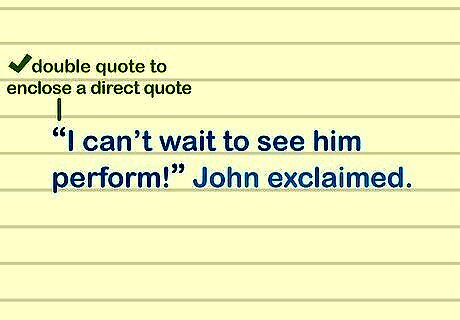
Use the double quotation mark ( " ) to enclose a direct quotation derived from either a spoken or written source. Generally speaking, quotation marks are used to denote that the information is a quote. In other words, whether you're recreating someone's verbal speech or simply re-writing something that they wrote elsewhere, you'll use quotation marks. Below are two examples of quotation mark usage:"I can't wait to see him perform!" John exclaimed. According to the article, the value of the dollar in developing nations is "strongly influenced by its aesthetic value, rather than its face value."

Use parentheses to clarify. Parentheses are often used to explain something that can't be deduced from the rest of the sentence. When using parentheses ( " ( ) " ), be sure to include the sentence's period after the closing parenthesis, except in the case that an entire sentence is within parentheses. Note that sometimes parentheses and commas can be used interchangeably. Here is an example of parentheses used for clarification:Steve Case (AOL's former CEO) resigned from the Time-Warner board of directors in 2005.
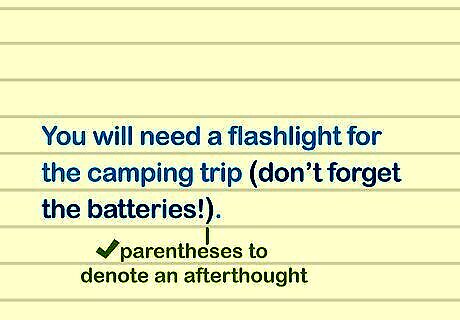
Use parentheses to denote an afterthought. Parentheses can also be used to contain information that is supplementary to the sentence they are part of. In this case, the line between using parentheses and starting a new sentence instead can be somewhat murky. A good general rule is to use parentheses for short additions and quips, not complex ideas. Here is an example of parentheses used for an afterthought. Note that the period (full stop) follows the last parenthesis — not before the first. Also note that replacing the parentheses with a comma may not be entirely suitable here, while a period or a semicolon may work: You will need a flashlight for the camping trip (don't forget the batteries!).
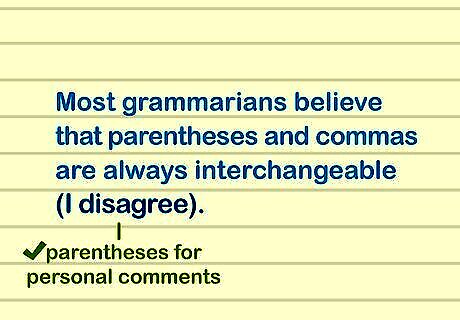
Use parentheses for personal comments. One additional usage of parentheses is to contain the writer's direct comments to the reader. Usually, the comments contained in parentheses refer to the preceding sentence. As above, the shorter and simpler the better. If you have to expound at great length or reference several disparate pieces of your writing, it's usually best to start a new sentence. Here is an example of parentheses used for a personal comment:Most grammarians believe that parentheses and commas are always interchangeable (I disagree).
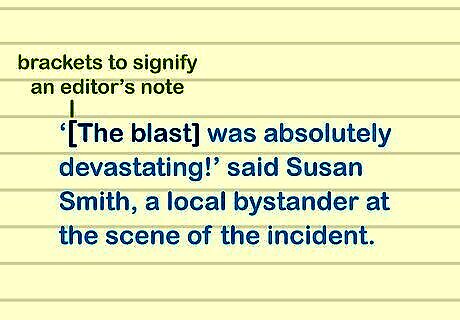
Use brackets to signify an editor's note in a regular piece of writing. You can also use brackets ( " [ ] " ) to clarify or to revise a direct quote. Brackets are often used to encompass the word "sic" (Latin for thus), indicating that the previous word or phrase was presented "as is," retaining an error in the original version. Here is an example of brackets used for clarity in a direct quote. (Note that the original quote was, "It was absolutely devastating!") "'[The blast] was absolutely devastating!' said Susan Smith, a local bystander at the scene of the incident.
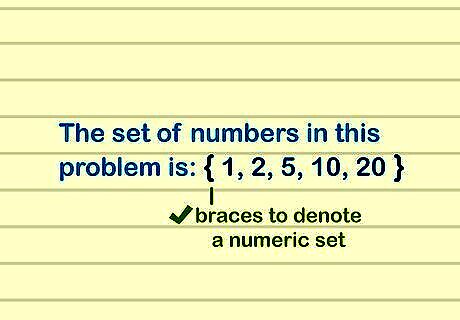
Use braces to denote a numeric set in mathematics. Less commonly, braces ( " { } " ) can also be used in regular writing to indicate a set of equal, independent choices. Here are two examples of brace usage. Note that the second is exceedingly rare:The set of numbers in this problem is: { 1, 2, 5, 10, 20 } Choose your favorite utensil { fork, knife, spoon } and bring it to me.


















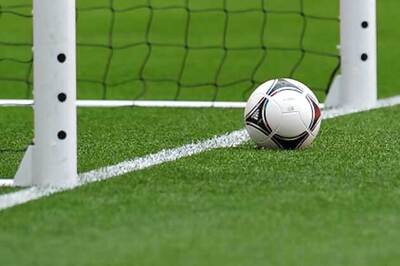

Comments
0 comment